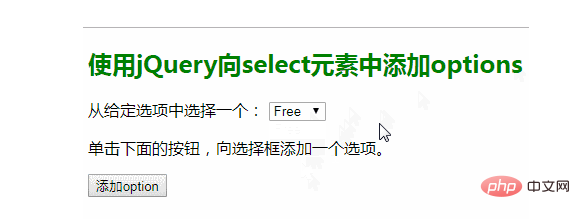How to add new option to select option box using jQuery
How to use jQuery to add new options to the select option box: 1. Add the options tag to the select element; 2. Use the [Option()] method to create a new option; 3. Create using value and text Create a new option element.

The operating environment of this tutorial: Windows 7 system, jquery version 3.3.1. This method is suitable for all brands of computers.
Related recommendations: "jQuery Video Tutorial"
How to use jQuery to add new options to the select option box:
Method 1: Add the options tag to the select element
First use the jquery selector to select the select element, and then use the append() method to add the options tag element. The append() method inserts the specified content into the last subcollection of the jQuery collection. This way the options element is added to the select element.
Syntax:
$('#selectBox').append(`${optionText}`)Example:
<!DOCTYPE html>
<html>
<head>
<meta charset="utf-8">
<title>如何使用jQuery向select元素中添加options?</title>
</head>
<body>
<h2 id="nbsp-使用jQuery向select元素中添加options"> 使用jQuery向select元素中添加options</h2>
<p>
从给定选项中选择一个:
<select id="select">
<option value="free">Free</option>
<option value="basic">Basic</option>
</select>
</p>
<p>单击下面的按钮,向选择框添加一个选项。</p>
<button onclick="addOption()">添加option</button>
<script src="https://code.jquery.com/jquery-3.3.1.min.js"></script>
<script type="text/javascript">
function addOption() {
optionText = 'Premium';
optionValue = 'premium';
$('#select').append(`<option value="${optionValue}"> ${optionText} </option>`);
}
</script>
</body>
</html>Rendering:

Method 2: Use Option () method creates new options
#Option() method is used to create new option elements. This method will create a new option using text and the value of the option as arguments. Then use the append() method to add this option element to the selection box.
Syntax:
$('#selectBox').append(new Option(optionText, optionValue))
Example:
<!DOCTYPE html>
<html>
<head>
<meta charset="utf-8">
<title>如何使用jQuery向select元素中添加options?</title>
</head>
<body>
<h2 id="nbsp-使用jQuery向select元素中添加options"> 使用jQuery向select元素中添加options</h2>
<p>
从给定选项中选择一个:
<select id="select">
<option value="hello">Hello</option>
<option value="hi">Hi</option>
</select>
</p>
<p>单击下面的按钮,向选择框添加一个选项。</p>
<button onclick="addOption()">添加option</button>
<script src="https://code.jquery.com/jquery-3.3.1.min.js"></script>
<script type="text/javascript">
function addOption() {
optionText = 'welcome';
optionValue = 'welcome';
$('#select').append(new Option(optionText, optionValue));
}
</script>
</body>
</html>Rendering:

Method 3: Using values and text creation creates a new option element
Creates a new jQuery DOM element using the option tag. The value of the option tag is set using the val() method, and the text of the option tag is set using the text() method. Then use the append() method to add the created option element to the selection box.
Grammar:
$('#selectBox').append($('<option>').val(optionValue).text(optionText))
Example:
<!DOCTYPE html>
<html>
<head>
<meta charset="utf-8">
<title>如何使用jQuery向select元素中添加options?</title>
</head>
<body>
<h2 id="nbsp-使用jQuery向select元素中添加options"> 使用jQuery向select元素中添加options</h2>
<p>
从给定选项中选择一个:
<select id="select">
<option value="free">Free</option>
<option value="basic">Basic</option>
</select>
</p>
<p>单击下面的按钮,向选择框添加一个选项。</p>
<button onclick="addOption()">添加option</button>
<script src="https://code.jquery.com/jquery-3.3.1.min.js"></script>
<script type="text/javascript">
function addOption() {
optionText = 'Extra';
optionValue = 'extra';
$('#select').append($('<option>').val(optionValue).text(optionText));
}
</script>
</body>
</html>Rendering:

For more programming-related knowledge, please visit : Programming learning! !
The above is the detailed content of How to add new option to select option box using jQuery. For more information, please follow other related articles on the PHP Chinese website!

Hot AI Tools

Undresser.AI Undress
AI-powered app for creating realistic nude photos

AI Clothes Remover
Online AI tool for removing clothes from photos.

Undress AI Tool
Undress images for free

Clothoff.io
AI clothes remover

Video Face Swap
Swap faces in any video effortlessly with our completely free AI face swap tool!

Hot Article

Hot Tools

Notepad++7.3.1
Easy-to-use and free code editor

SublimeText3 Chinese version
Chinese version, very easy to use

Zend Studio 13.0.1
Powerful PHP integrated development environment

Dreamweaver CS6
Visual web development tools

SublimeText3 Mac version
God-level code editing software (SublimeText3)

Hot Topics
 Detailed explanation of jQuery reference methods: Quick start guide
Feb 27, 2024 pm 06:45 PM
Detailed explanation of jQuery reference methods: Quick start guide
Feb 27, 2024 pm 06:45 PM
Detailed explanation of jQuery reference method: Quick start guide jQuery is a popular JavaScript library that is widely used in website development. It simplifies JavaScript programming and provides developers with rich functions and features. This article will introduce jQuery's reference method in detail and provide specific code examples to help readers get started quickly. Introducing jQuery First, we need to introduce the jQuery library into the HTML file. It can be introduced through a CDN link or downloaded
 How to use PUT request method in jQuery?
Feb 28, 2024 pm 03:12 PM
How to use PUT request method in jQuery?
Feb 28, 2024 pm 03:12 PM
How to use PUT request method in jQuery? In jQuery, the method of sending a PUT request is similar to sending other types of requests, but you need to pay attention to some details and parameter settings. PUT requests are typically used to update resources, such as updating data in a database or updating files on the server. The following is a specific code example using the PUT request method in jQuery. First, make sure you include the jQuery library file, then you can send a PUT request via: $.ajax({u
 In-depth analysis: jQuery's advantages and disadvantages
Feb 27, 2024 pm 05:18 PM
In-depth analysis: jQuery's advantages and disadvantages
Feb 27, 2024 pm 05:18 PM
jQuery is a fast, small, feature-rich JavaScript library widely used in front-end development. Since its release in 2006, jQuery has become one of the tools of choice for many developers, but in practical applications, it also has some advantages and disadvantages. This article will deeply analyze the advantages and disadvantages of jQuery and illustrate it with specific code examples. Advantages: 1. Concise syntax jQuery's syntax design is concise and clear, which can greatly improve the readability and writing efficiency of the code. for example,
 jQuery Tips: Quickly modify the text of all a tags on the page
Feb 28, 2024 pm 09:06 PM
jQuery Tips: Quickly modify the text of all a tags on the page
Feb 28, 2024 pm 09:06 PM
Title: jQuery Tips: Quickly modify the text of all a tags on the page In web development, we often need to modify and operate elements on the page. When using jQuery, sometimes you need to modify the text content of all a tags in the page at once, which can save time and energy. The following will introduce how to use jQuery to quickly modify the text of all a tags on the page, and give specific code examples. First, we need to introduce the jQuery library file and ensure that the following code is introduced into the page: <
 How to remove the height attribute of an element with jQuery?
Feb 28, 2024 am 08:39 AM
How to remove the height attribute of an element with jQuery?
Feb 28, 2024 am 08:39 AM
How to remove the height attribute of an element with jQuery? In front-end development, we often encounter the need to manipulate the height attributes of elements. Sometimes, we may need to dynamically change the height of an element, and sometimes we need to remove the height attribute of an element. This article will introduce how to use jQuery to remove the height attribute of an element and provide specific code examples. Before using jQuery to operate the height attribute, we first need to understand the height attribute in CSS. The height attribute is used to set the height of an element
 Use jQuery to modify the text content of all a tags
Feb 28, 2024 pm 05:42 PM
Use jQuery to modify the text content of all a tags
Feb 28, 2024 pm 05:42 PM
Title: Use jQuery to modify the text content of all a tags. jQuery is a popular JavaScript library that is widely used to handle DOM operations. In web development, we often encounter the need to modify the text content of the link tag (a tag) on the page. This article will explain how to use jQuery to achieve this goal, and provide specific code examples. First, we need to introduce the jQuery library into the page. Add the following code in the HTML file:
 Understand the role and application scenarios of eq in jQuery
Feb 28, 2024 pm 01:15 PM
Understand the role and application scenarios of eq in jQuery
Feb 28, 2024 pm 01:15 PM
jQuery is a popular JavaScript library that is widely used to handle DOM manipulation and event handling in web pages. In jQuery, the eq() method is used to select elements at a specified index position. The specific usage and application scenarios are as follows. In jQuery, the eq() method selects the element at a specified index position. Index positions start counting from 0, i.e. the index of the first element is 0, the index of the second element is 1, and so on. The syntax of the eq() method is as follows: $("s
 How to tell if a jQuery element has a specific attribute?
Feb 29, 2024 am 09:03 AM
How to tell if a jQuery element has a specific attribute?
Feb 29, 2024 am 09:03 AM
How to tell if a jQuery element has a specific attribute? When using jQuery to operate DOM elements, you often encounter situations where you need to determine whether an element has a specific attribute. In this case, we can easily implement this function with the help of the methods provided by jQuery. The following will introduce two commonly used methods to determine whether a jQuery element has specific attributes, and attach specific code examples. Method 1: Use the attr() method and typeof operator // to determine whether the element has a specific attribute






